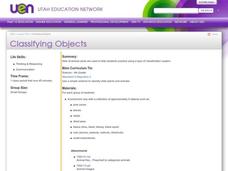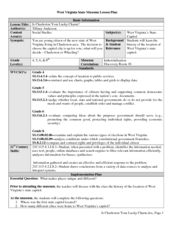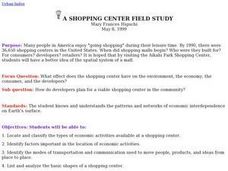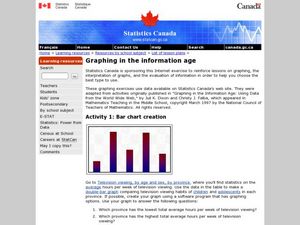Curated OER
Dual place names in Australia
Students discuss landmarks commonly found on maps. They are divided into two groups, and asked to draw a map for a friend who hasn't been to the area. Group A may use street and place names, group B may not. Students discuss the role of...
Curated OER
Measuring Techniques - Level I
Demonstrate food preparation techniques of salads, soups, casseroles, breads, meats, poultry and pastries.
Curated OER
Sizing Up Servings
Students learn the definition of a suggested serving size and re-define their daily food intake in terms of these recommended amounts.
Curated OER
Post Civil War Reconstruction
Students analyze the process of Reconstruction after the Civil War. In this U.S. History lesson, students discuss specific details about Reconstruction with the class, then complete a worksheet with multiple activities reinforcing the...
Curated OER
What is a Family?
Students explore how Canadian families have evolved over time. In this census results lesson, students examine the factors that contribute to changing family and household structures. Students also create written and illustrated profiles...
Curated OER
Why Nations Trade
Students examine how international trade affects a nation's economy. They read and analyze two handouts, research a scenario from the handout, determine the chronological order of the scenarios, and answer questions about a case study.
Curated OER
Why Nations Trade
Students explore the concept of international trade. In this economics instructional activity, students read the 2 provided handouts about international trade and then discuss their content.
Curated OER
Economic Decision-Making
Tenth graders examine the cultural values of the Aboriginal people of Canada. In this global economics lesson, 10th graders discuss how capitalistic economies have changed the traditional values of the Aboriginal people in Canada.
Curated OER
Hey, Mom! What's for Breakfast?
Students examine how he world eats breakfast. In this food choices lesson, students work in groups to list breakfast foods and their ingredients and find goods and consumers on the list. The, students use the Internet to complete a...
Curated OER
Wind Power and Your Community
Students acquire knowledge about hydropower, diesel power, wind power, and how they are currently used in the north. They share what they have learned through a jigsaw activity.
Curated OER
My Living Arrangements
Students identify various housing options, focusing on rental vs. purchase and short vs. long term. With a partner, students discuss their housing situation. Once their discussion is complete, students write a brief paragraph weighing...
Curated OER
The Void Filled by Nonprofits
High schoolers examine the significance of nonprofit organizations in a democratic society. They conduct research on a selected nonprofit organization, complete a questionnaire, and present their findings to the class.
Curated OER
Classifying Objects
Fourth graders work in small groups to sort and classify a variety of objects. They develop criteria for sorting and explain the characteristics they chose for classification. Groups record and share their classifications.
Curated OER
Where the Red Fern Grows: A 4th Grade Literary Focus Unit
Fourth graders explore the human and animal connection along with the idea that death is a part of the life cycle. They read "Where the Red Fern Grows." Students examine the feelings and emotions surrounding death and they discover the...
Curated OER
Women's Involvement In The Progressive Era
High schoolers participate in a lesson plan that is investigating the Progressive Era of history. They conduct research focusing on the role of women in era. The information provides the perspectives necessary to address the popular...
Curated OER
Is Charleston Your Lucky Charm?
Students determine what makes Charleston, West Virginia unique. In this West Virginia history lesson plan, students explore the West Virginia History Museum to identify why Charleston became the capitol of the state.
Curated OER
Alexander Graham Bell's Patent for the Telephone and Thomas Edison's Patent for the Electric Lamp
Students read a short biographical account about Bell and student B about Edison. Ask each pair to exchange information and determine what qualities these inventors shared. Ask students if they think all inventors share these qualities.
Curated OER
The Unseen Army: Conscientious Objectors During World War II
Learners study World War II and why it was called "the Good War". In this World War II activity learners identify the different kinds of conscientious objectors.
Curated OER
My Rotten Red-Headed Brother
Students discuss family relationships after reading Patricia Polacco's book, My Rotten Red-Headed Brother.
Curated OER
A Shopping Center Field Study
Students analyze how developers plan for a shopping center. They take a field trip to a nearby shopping center. Also students participate in a shopping center scavenger hunt. Students identify factors important to the location of...
Curated OER
ABC's Of Figuring Interest
High schoolers participate in a lesson of figuring interest. This is done in order to strengthen number calculation skills while computing the interest when buying different things. This done in conjunction with using credit to make...
Curated OER
Graphing in the Information Age
Students create a variety of graphs based on population data. In this statistics instructional activity, students use data that can be gathered on-line to make a bar chart, line graph, and circle graph.
Curated OER
Writing Newspaper Articles
Students write newspaper articles regarding their service learning experiences. In this writing skills lesson, students review the writing process skills to develop high-quality articles. Students write articles regarding the their acts...

























